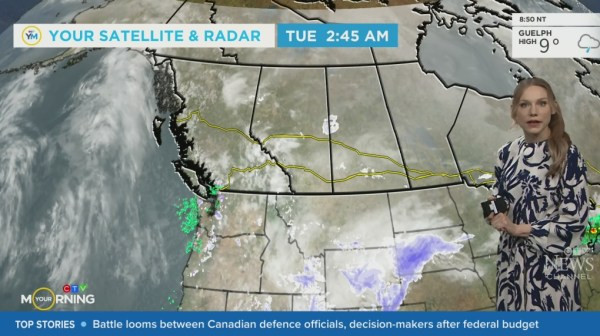At noon AEST on Wednesday, the benchmark S&P/ASX200 index was down 48.4 points, or 0.6 per cent, to 8,022.8, while the broader All Ordinaries had dropped 47.9 points, or 0.58 per cent, to 8,249.2.
The fall came as traders took profits from two and a half weeks of gains ahead of Nvidia's second-quarter earnings report, due early Thursday, to see if the AI chipmaker could continue its jaw-dropping run of earnings blowouts.
Amid the frenzy over all things AI, Nvidia has surged to a $4.6 trillion market capitalisation, making it the world's second most valuable company, behind Apple.
Closer to home, the Australian Bureau of Statistics reported Wednesday that consumer prices rose 3.5 per cent in the year to July, down from 3.8 per cent in the year to June.
While forecasts had been for a 3.4 per cent inflation readout, IG analyst Tony Sycamore said the overall result was largely expected and unlikely to change the dial for the Reserve Bank at its meeting next month.
The Aussie briefly jumped above 68 US cents following the readout, its highest level this year.
Nine of the ASX's 11 sectors were lower at midday, with consumer staples higher and real estate basically flat.
The telecommunications sector was the biggest mover, dropping 1.5 per cent as Telstra, trading ex-dividend, fell 2.8 per cent.
Tabcorp was the biggest loser in the ASX200 at midday, falling 12.4 per cent to a four-year low of 49.5c after the gambling company posted a $1.4 billion loss after taking a huge writedown on the value of its wagering assets.
Incoming managing director and chief executive Gillon McLachlan said Tabcorp had built solid foundations since its demerger but was only part way through a turnaround, and would clearly not meet its "TAB25" targets set two years ago.
Woolworths was up 2.4 per cent to $36.32 after the supermarket group announced that its full-year sales were up 3.7 per cent to $67.9 billion.
In the heavyweight mining sector, BHP was down 1.8 per cent, Rio Tinto had dropped 1.3 per cent and Fortescue had fallen 1.8 per cent.
Goldminers were mixed even as the precious metal changed hands at $US2,516 ($A3,702) an ounce, just shy of its all-time high set earlier this week.
Newmont was up 0.2 per cent, while Northern Star had dropped 0.6 per cent and Evolution had dipped 0.1 per cent.
Mid-tier goldminers were faring better, with Ramelius up 2.6 per cent and Regius adding 2.1 per cent.
In the financial sector, the big four banks were also mixed. ANZ had advanced 0.6 per cent, Westpac was flat, NAB had dipped 0.4 per cent and CBA was down 0.2 per cent.
The Australian dollar was buying 67.99 US cents at midday, from 67.86 US cents at Tuesday's ASX close.
The Aussie Dollar Gets a Boost
The S&P/ASX200 had been down as much as 62.3 points, or 0.77 per cent, in late morning trading.
But the benchmark index turned things around Wednesday afternoon to finish on the highs of the day at 8,071.4, up two-tenths of a point from Tuesday's close.
The broader All Ordinaries dropped 5.8 points, or 0.07 per cent, to 8,291.3.
The volatility came after the Australian Bureau of Statistics reported that consumer prices rose 3.5 per cent in the year to July, down from 3.8 per cent in the year to June but slightly more than the 3.4 per cent rate that economists had expected.
Betashares chief economist David Bassanese said that the Reserve Bank wasn't likely to be overly excited by the result, and it didn't add to the case for a rate cut anytime soon.
The government's new electricity subsidies helped lower annual inflation by two-tenths of a point, Mr Bassanese said, but they are only a temporary measure and will roll off.
The Aussie dollar briefly jumped above 68 US cents following the inflation readout, its highest level since December.
Five of the ASX's 11 sectors finished lower on Wednesday and five finished higher, with health care flat.
The telecommunications and energy sector were the biggest movers, both falling 1.4 per cent.
Telstra, trading ex-dividend, dropped 2.5 per cent to $3.90, helping weigh down the latter, while in the energy sector the losses were more widespread.
Woodside fell 1.2 per cent, Whitehaven Coal dropped 3.0 per cent and Paladin Energy retreated 5.9 per cent as uranium miners gave back some of their gains from earlier in the week.
Tabcorp was the biggest loser in the ASX200, falling 15.0 per cent to a four-year low of 48c after the gambling company posted a $1.4 billion loss after taking a huge writedown on the value of its wagering assets.
Incoming managing director and chief executive, Gillon McLachlan, said Tabcorp had built solid foundations since its demerger but was only part way through a turnaround, and would clearly not meet its "TAB25" targets set two years ago.
Woolworths rose 3.3 per cent to $36.62 after the supermarket group announced that its full-year sales were up 3.7 per cent to $67.9 billion amid strong growth in its e-commerce and retail media segments.
EToro market analyst Josh Gilbert said shareholders would be pleased with the results, especially a special dividend that took its full-year dividends to $1.44 per share, which some would see as well deserved for sticking with the business through a difficult period.
In the heavyweight mining sector, BHP fell 1.4 per cent to $40.76, Rio Tinto dropped 0.9 per cent to $110.89 and Fortescue retreated 1.0 per cent to $18.44.
In the financial sector, the Big Four banks all finished higher after mostly being in the red earlier in the day.
ANZ rose 1.0 per cent to $29.92, Westpac added 1.1 per cent to $30.83, NAB advanced 0.9 per cent to $37.70 and CBA climbed 0.8 per cent to $138.57.
Buy now, pay later company, Zip, was the biggest gainer in the ASX200, rising 13.9 per cent to a more than two-year high of $2.38 after broker upgrades and chatter about a potential integration into Apple's wallet feature.
At 5pm, the Australian dollar was buying 67.96 US cents, from 67.86 US cents at Tuesday's ASX close.
A Peek at the Future: Rates and the Aussie Dollar
The latest inflation data has sparked a wave of speculation about the future direction of interest rates and the Australian dollar. While the Aussie dollar received a short-term boost, concerns remain about the overall trajectory of the economy. The Reserve Bank of Australia (RBA) has signaled that it’s not ready to cut rates anytime soon, despite some downward pressure on inflation. This means that interest rates are likely to stay high for the foreseeable future, posing challenges for households and businesses alike.
The market is currently pricing in a rate cut in December, but some economists argue that this is overly optimistic given the persistent inflation. The Aussie dollar, meanwhile, could see continued volatility as investors grapple with these uncertain economic prospects. While the latest inflation figures offer a sliver of optimism, the challenges remain significant, and the Australian economy is likely to remain under pressure for some time.
Looking Ahead: What’s Next for the Aussie Economy?
While the latest inflation figures offer a glimmer of hope, the Australian economy faces ongoing challenges. With interest rates expected to remain high, households and businesses will continue to grapple with higher borrowing costs. The RBA’s stance on rate cuts will be crucial in determining the trajectory of the economy in the coming months. The Aussie dollar is likely to remain volatile as investors weigh the economic outlook. Stay tuned for further developments as the Australian economy navigates these uncertain waters.
Inflation's Impact: A Look at Key Sectors
The impact of inflation is being felt across various sectors of the Australian economy. The retail sector, for instance, is experiencing strong growth in e-commerce and retail media segments, as consumers seek out online shopping options and alternative ways to save money. However, the construction sector is facing significant challenges due to rising costs, with construction work growing by a mere 0.1%. This paints a mixed picture of the Australian economy, with some sectors thriving while others struggle.
The Road Ahead: Uncertainty Looms
The Australian economy is at a crossroads. Inflation is showing signs of slowing, but the RBA remains cautious about cutting rates, leaving households and businesses in a state of uncertainty. The future direction of the Aussie dollar will be influenced by the RBA's actions, the global economic environment, and the ongoing impact of inflation. The path ahead is uncertain, but one thing is clear: the Australian economy is facing a challenging period of adjustment.

















